This is a Fujica V2, a 35mm rangefinder camera built by Fuji Photo Film Co., Ltd in Japan starting in 1965. The Fujica V2 was a pretty advanced camera for it’s day featuring shutter priority automatic exposure via a coupled CdS meter, a sharp 6-element Fujinon lens, and a full information viewfinder that not only was automatically parallax corrected, but displayed both the chosen shutter speeds and aperture f/stops. Like other Fujica rangefinders, the V2 had a rear thumbwheel focus and a side mounted rewind knob, giving the camera a unique operation and clutter free design.
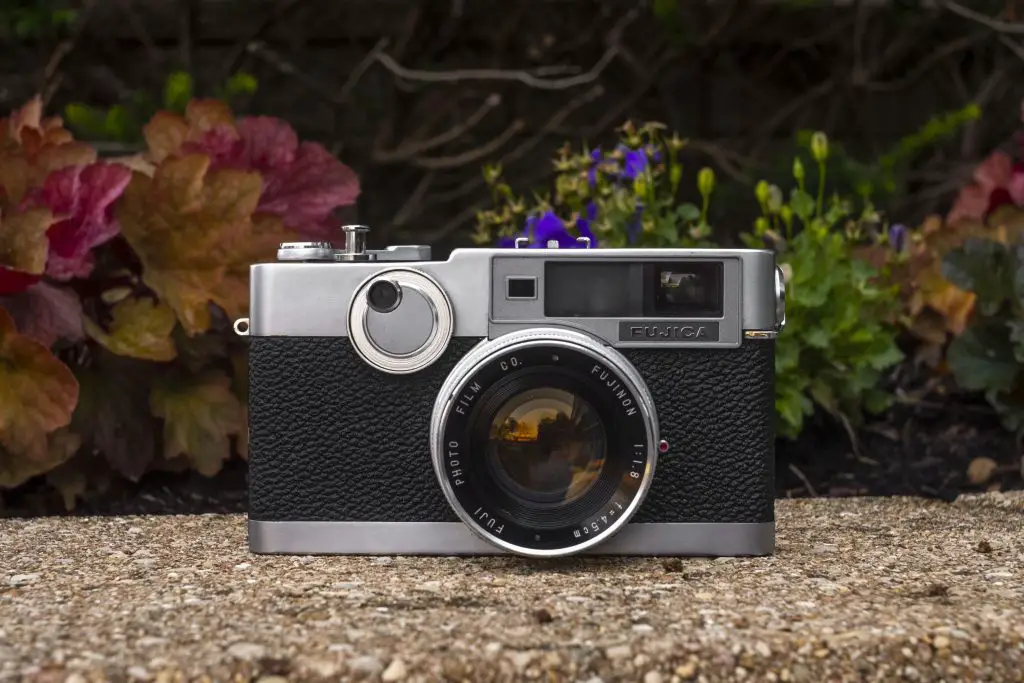 Film Type: 135 (35mm)
Film Type: 135 (35mm)
Lens: 4.5cm f/1.8 Fujinon coated 6-elements in 5-groups
Focus: 3 feet to Infinity, Rear Thumb Wheel
Viewfinder: Coincident Image Coupled Rangefinder with Parallax Correction and Speed and F/stop Indicators
Shutter: Citizen MXV Leaf
Speeds: B, 1 – 1/500 seconds
Exposure Meter: Coupled Selenium Cell w/ top plate match needle and Aperture Priority AE
Battery: 1.35v PX625 Mercury Battery
Flash Mount: Cold shoe with M and X Flash Sync
Weight: 789 grams
Manual: https://www.cameramanuals.org/fuji_pdf/fujica_v2-original.pdf
How these ratings work |
The Fujica V2 is a robust, full figured rangefinder made at a period of time when Japanese rangefinders were some of the best in the world. Offering just the right balance of new technology, modern features, but combined with the classic feel and operation of a fully mechanical camera, the Fujica V2 is as much of a joy to shoot as it is capable. Combined with a unique back wheel focus, a full information viewfinder, shutter priority automatic exposure, and a great lens, this is an outstanding camera to shoot. | ||||||
| Images | Handling | Features | Viewfinder | Feel & Beauty | History | Age | |
| 2 | 2 | 1 | 2 | 2 | 0 | 20% | |
| Bonus | none | ||||||
| Final Score | 10.8 | ||||||
History
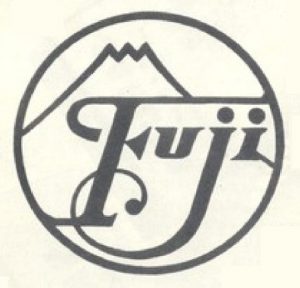 The Japanese camera industry was made up of a huge number of companies. From industry leaders like Canon and Nippon Kogaku (Nikon) to small workshops like Shinano and Taiyodo whose products barely made a splash.
The Japanese camera industry was made up of a huge number of companies. From industry leaders like Canon and Nippon Kogaku (Nikon) to small workshops like Shinano and Taiyodo whose products barely made a splash.
Somewhere in the middle were a huge number of quality camera makers whose designs were ever bit as good as everything else, but struggled in a very crowded marketplace to stand out. Most companies would try to find a niche that worked for them, whether it was making medium format TLRs, compact scale focus point and shoots, or mid level 35mm SLRs.
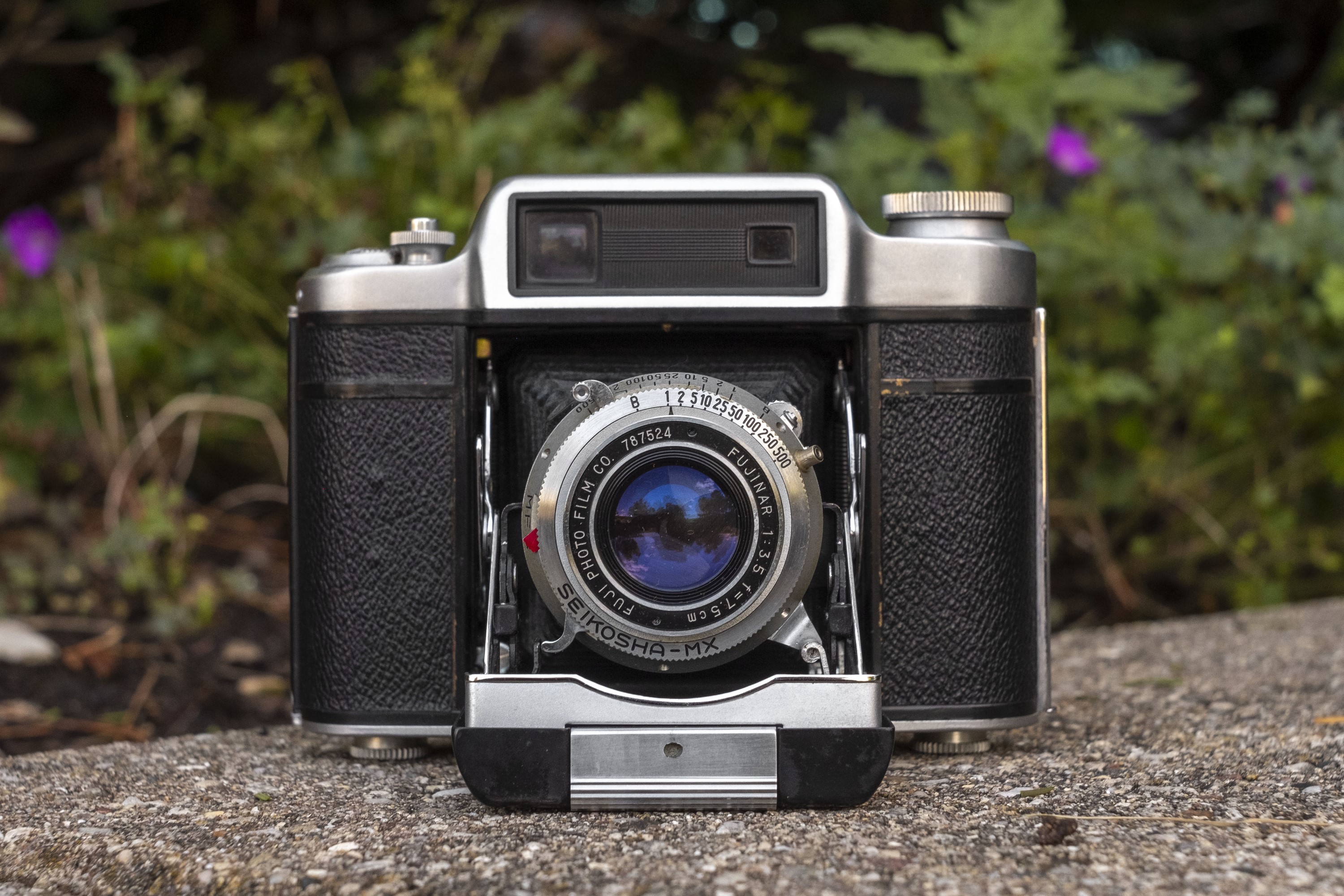
Fuji Photo Film’s niche seemed to be clever implementations of existing designs. Fuji did not stick to one specific format of camera as they made everything from medium format 6×17 panoramic cameras to leaf shutter SLRs to wind up motorized drive half frame point and shoots.
In 1957, Fuji would release the company’s first 35mm rangefinder camera, the Fujica 35 M. Although there were already a number of Japanese rangefinder cameras in the market, most were either interchangeable lens models, or were very basic inexpensive models.
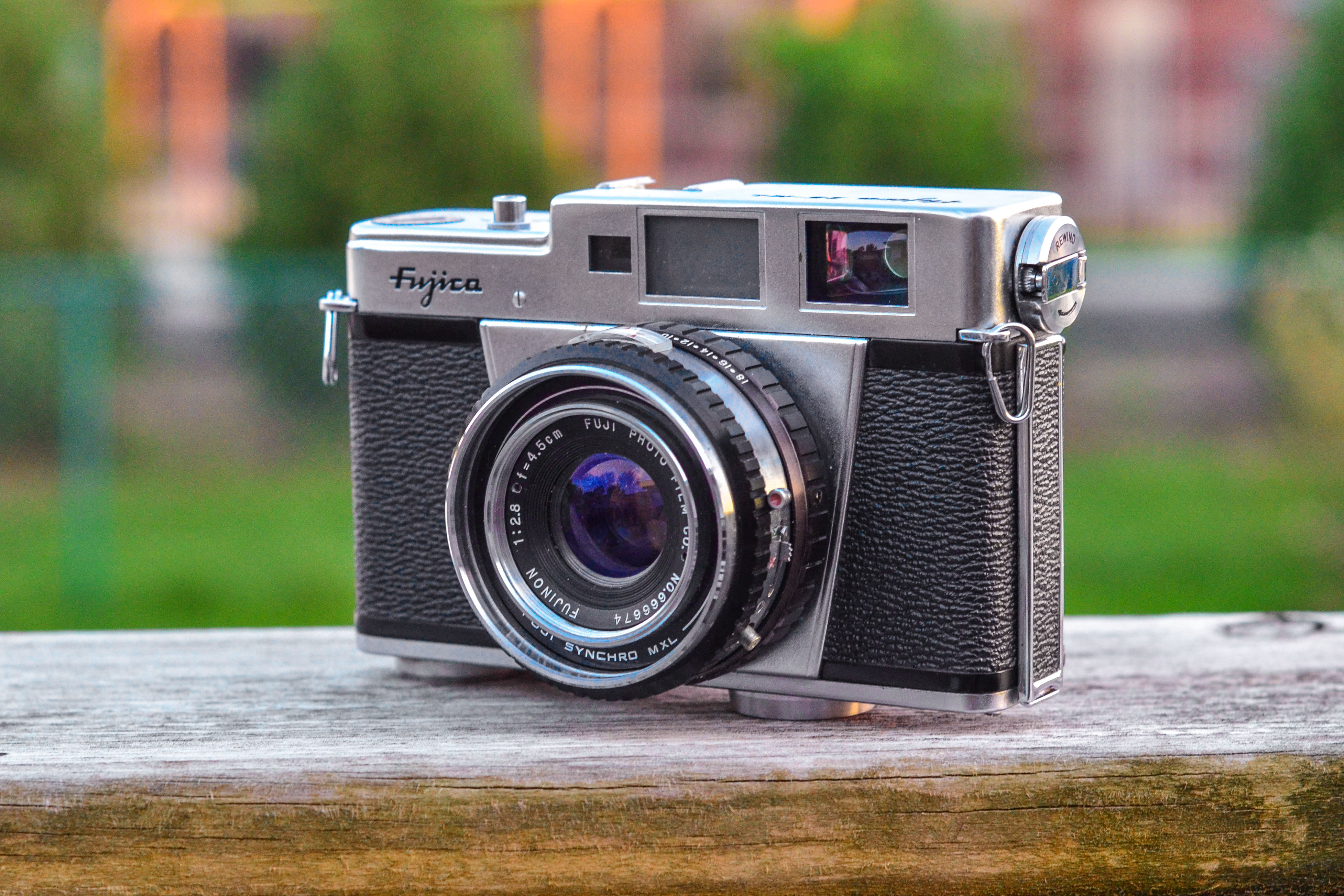
The Fujica 35 M was right in the middle, a well built, compact, yet advanced, yet not too expensive model that helped establish a Japanese camera maker as a viable option for someone looking for a good, but not professional level rangefinder.
To further separate themselves from just another camera maker, Fuji borrowed a feature from the 1950 Voigtländer Vitessa which was the back wheel focus. The benefit to this was that the wheel was located in a position where the photographer’s right thumb would naturally lay, plus by not having to include a focus ring on the lens, allowed for more room for the shutter speed and aperture rings.
The Fujica 35 M was a mild success, but more importantly, opened the door for further Fuji camera development. Next came the Fujica 35 ML which improved the shutter with a faster 1/500 speed and a coupled LV scale.
Next was the Fujica 35 SE and EE models with a match needle exposure meter, and auto exposure respectively. Fujica cameras were getting more capable, with better features, and faster lenses. Of course the prices were going up as well, as Fuji could now compete in the advanced amateur segment with other Japanese companies like Minolta, Konica, and Yashica.
In 1965 came the Fujica V2, which featured the company’s fastest f/1.8 six-element Fujinon lens, a full information viewfinder with automatic parallax correction, a redesigned and less cluttered body with more traditional top lever film advance, and an all new Cadmium Sulfide exposure meter with shutter priority auto exposure, the Fujica V2 was the company’s most advanced 35mm rangefinder camera.
In advertising for the V2, Fuji heavily promoted the camera’s combination of advanced auto exposure with a fast lens. Although it wasn’t the only camera on the market with a fast lens and auto exposure, Fuji’s clean design, and back wheel focus made it stand out from the competition.

As a price of $99.50 which compares to about about $875 today, the Fujica V2 was a cost effective option for the photographer who wanted modern simplicity, in an easy to use form factor and with an excellent lens. In their April 1966 Modern Tests column, the editors of Modern Photography declared the Fujica V2 to be “a surprising amount of camera for the money”. Sure, there were other advanced rangefinders like the Minolta Hi-Matic 7 and Konica Auto S already on the market, but not at the Fujica’s price point.
Positive comments were made of the camera’s ergonomics, thumbwheel focus, bright and easy to use viewfinder, uncomplicated metering system, and excellent lens. The review gives a good tip that the Fujica V2’s metering system is constantly on, and the only way to turn it off is by changing the film speed dial to an unmarked ASA/DIN setting (I was not able to confirm this myself).
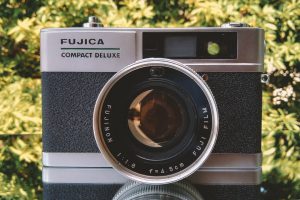
Overall, the camera had all the necessary chops to be a top tier camera, but a lack of information and a complete disappearance of ads for it after 1966 suggest it wasn’t in production for long. I was never able to find any information about production numbers, but in 1967, Fujica would release the Compact Deluxe, a camera with very similar specifications as the V2, but in a more more compact body. Perhaps a preference for smaller cameras, an overly crowded rangefinder market, the growing popularity of the SLR all contributed to a short life span for the V2.
Today, 1960s Japanese rangefinders by all companies are sought after by collectors and users alike. This era produced some of the best fixed lens rangefinders ever made. Most of the models from this era had some type of metering, usually with auto exposure, good ergonomics, excellent build quality, and amazing lenses. The Fujica V2 has all that’s great from those other models, with just enough that’s different to make it worth seeking out. Although no camera is impervious to the rigors of time, if you can find a properly working example, you will no doubt be impressed with the results you’ll get.
My Thoughts
The mid 20th century saw a huge number of Japanese rangefinders from dozens of companies. Regardless of your budget or expectations, there was something for everyone. Top of the line models like the Nikon SP had an interchangeable lens mount, a viewfinder with 6 different focal lengths, and a huge system of accessories were ideal for professional photographers. For someone on a budget, the fixed lens Minolta A might be ideal for you.
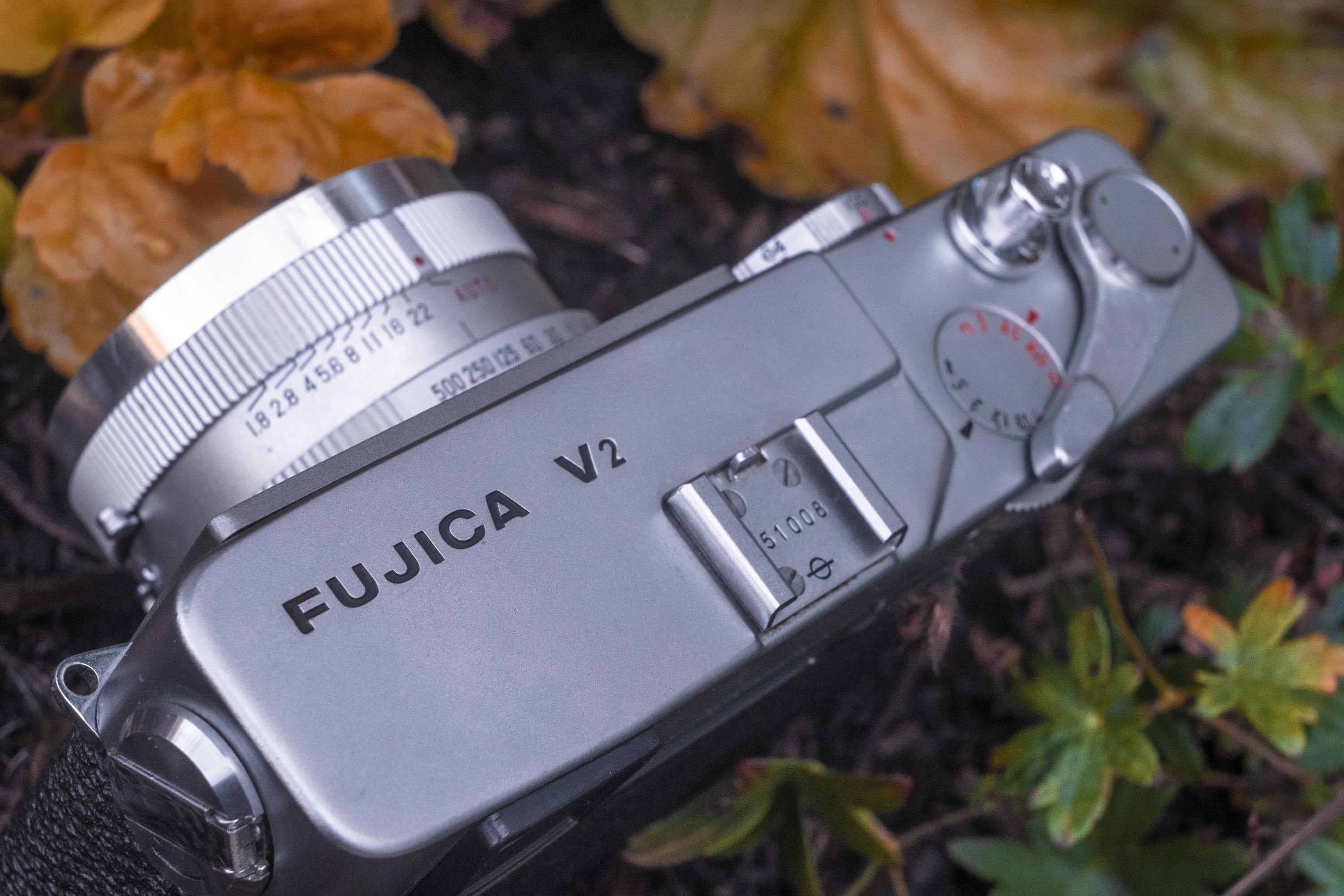
I can imagine that if I were in the market for a 35mm camera in the mid 1960s, selecting which model was right for me might have been intimidating. I’m usually not one to buy the top of the line of anything, but I believe in the mantra “buy cheap, buy twice”, so mid-level models are likely what I would consider.
Right there in the middle was Fuji with a selection of nice, but not amazing cameras. I’ve previously reviewed the excellent Fujica 35-ML rangefinder, the half frame motor drive Fujica Drive, the fully automatic point and shoot Fujica 35 Automagic, and the Fujicarex II leaf shutter SLR.
Today’s review of the Fujica V2 represents the closest to a “flagship” rangefinder offered by the company. Although Fuji never directly competed with Nikon or Canon cameras, the Fujica V2 packed a great deal of technology into it’s body. I had wanted to shoot one of these for a while, but finding one for a reasonable price proved to be difficult. My first camera had both a sticky shutter and dead meter. I was able to clean the shutter and get it working, but the meter remained dead. I ended up having to get a second camera to do this review, but when I did, I was happy to load in a couple rolls of film to see what it was capable of.
The Fujica V2 is from the era when Japanese camera makers made what I call “full figured” cameras. The V2 has broad shoulders which are accented by 90 degree angled corners on all sides. With a weight of 789 grams empty, load in a battery and a roll of film and the scale tops 800 grams, which is compact SLR territory.
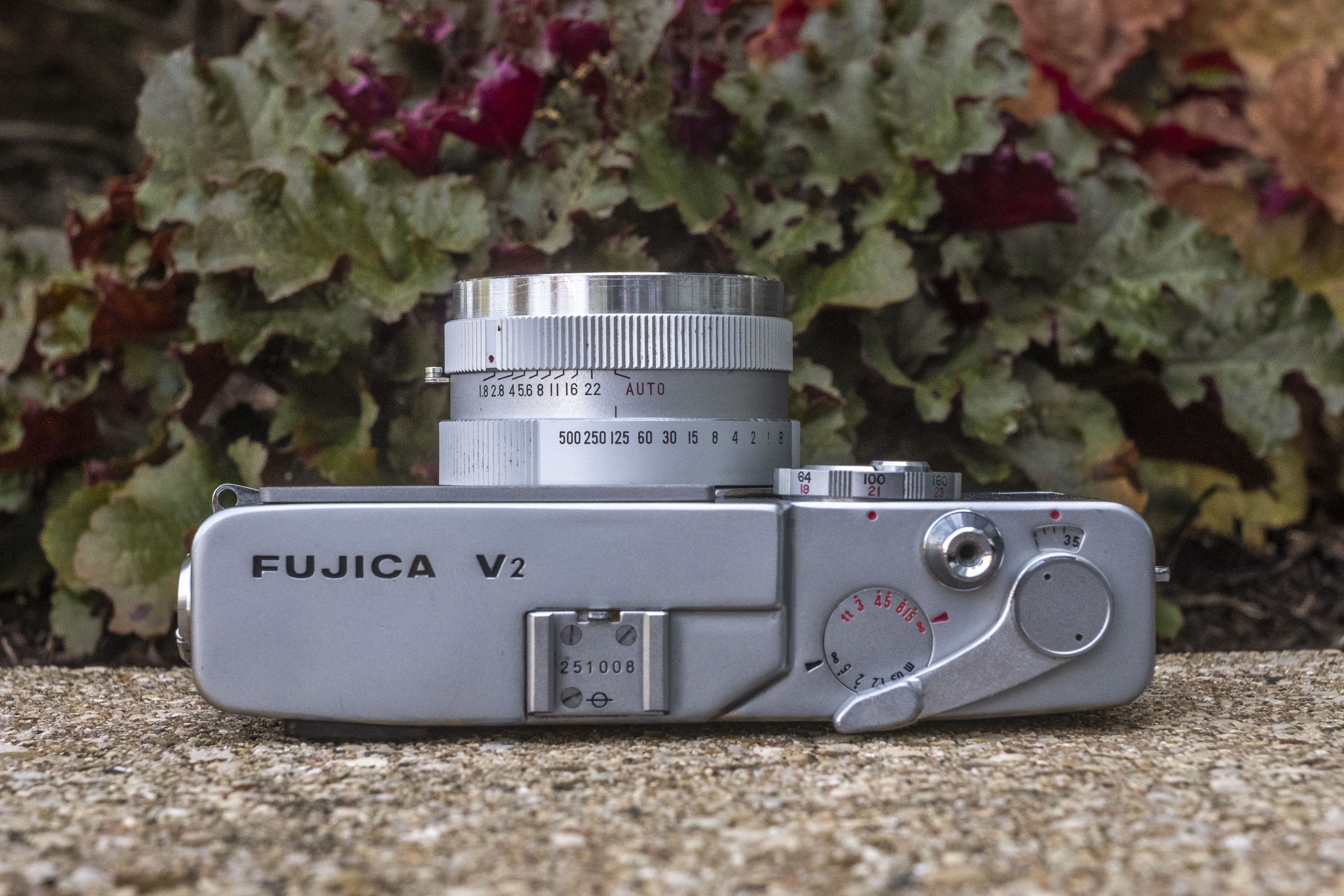
The top plate, like other Fujica cameras of the era is very clean. The left side consists entirely of the Fujica V2 logo and the accessory shoe in the middle. Off to the right is the film advance lever, threaded shutter release, and automatic resetting exposure counter. Just above the tip of the advance lever is a focusing scale showing distances in both meters and feet, which for someone whose never used a mid century Fujica camera before might seem weird, until you realize that’s because of the back wheel focus control.

Whether it was intentional or not, Fuji took a design cue used by Voigtländer with a relocated focus control on the back plate of the camera which first appeared on the Voigtländer Vitessa in 1950. There are two main benefits to this. The first is the photographer’s right thumb can control focus, leaving the left hand entirely to stabilize the camera, thus making focusing easier. The other is that by not having to dedicate space for a focusing ring on the lens, more of the lens can be used for changing shutter speeds and f/stops, without having to make the lens barrel larger, or the rings smaller.
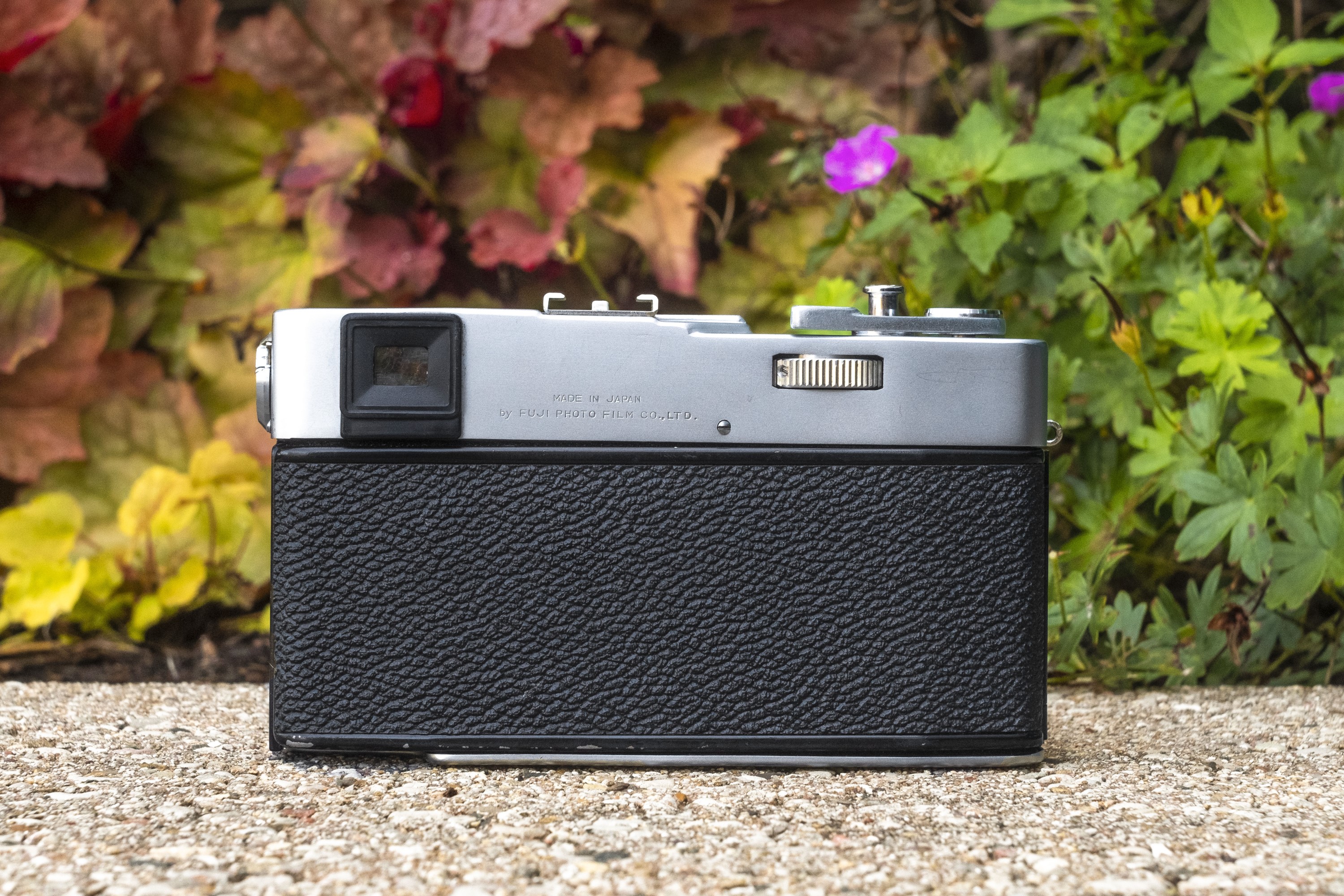
In use, the back wheel focus is conveniently located exactly where your right thumb would naturally be which makes it’s use simple, however in the time I shot the V2, the Vitessa, or any of Fuji’s other cameras with this feature, I can’t say with any certainty that it’s better than a traditional lens mounted focus. At the very least, I can say it’s not worse and does add a neat quirk to this camera not found on many others.
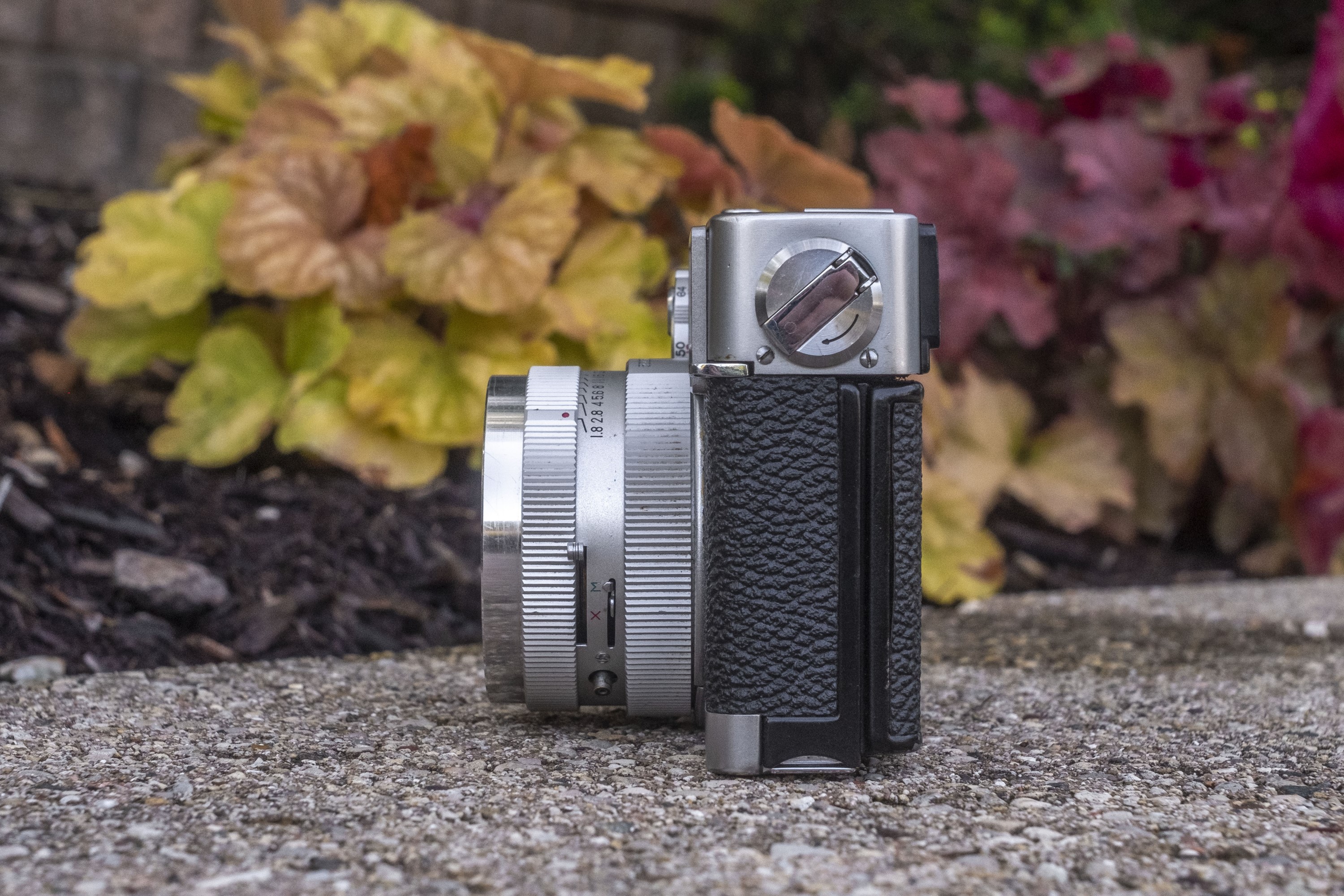
Another common design element for a Fujica camera is the fold out rewind knob on the camera’s left side. The side mounted knob works exactly like a top knob, but connects to the supply spool using a 90 degree gear. The advantage of having the knob on the side is that it frees up space on the top plate to reduce clutter, but also allows for the viewfinder to be positioned farther in the upper left corner of the camera’s back. Whether this has any practical benefit is unclear, especially on the large size of the V2. On more compact models, you could see this as a way of reducing size, but that’s clearly not what’s happening here. Also on this side is the release latch for the film compartment door.

The Fujica V2’s film compartment has a left to right film transport onto a fixed and single slotted take up spool. Due to the side mounted rewind knob, there is no way to lift up on the fork that goes into the cassette, so the V2 has a notch in the bottom of the left side of the camera which allows you to slide in a new roll of film from the bottom.
The film pressure plate is very large and has dimples to reduce friction as film passes over it. Also present is a film roller and a metal clip to help maintain film flatness as it travels through the camera. Mine had a silver and red Fuji Film sticker, which adds a little bit of color to this area of the camera. There is a black screw in the middle of the top film rail which I am unsure of what it does. I don’t believe it is a rangefinder adjustment screw as it looks to be too low to be inline with anything to do with the focusing system.

The bottom of the camera has the rewind release button, centrally located 1/4″ tripod socket, opening for the PX625 mercury battery, and the notch in the door for loading film. From this angle, you can also see the flash sync connector near the bottom of the shutter.
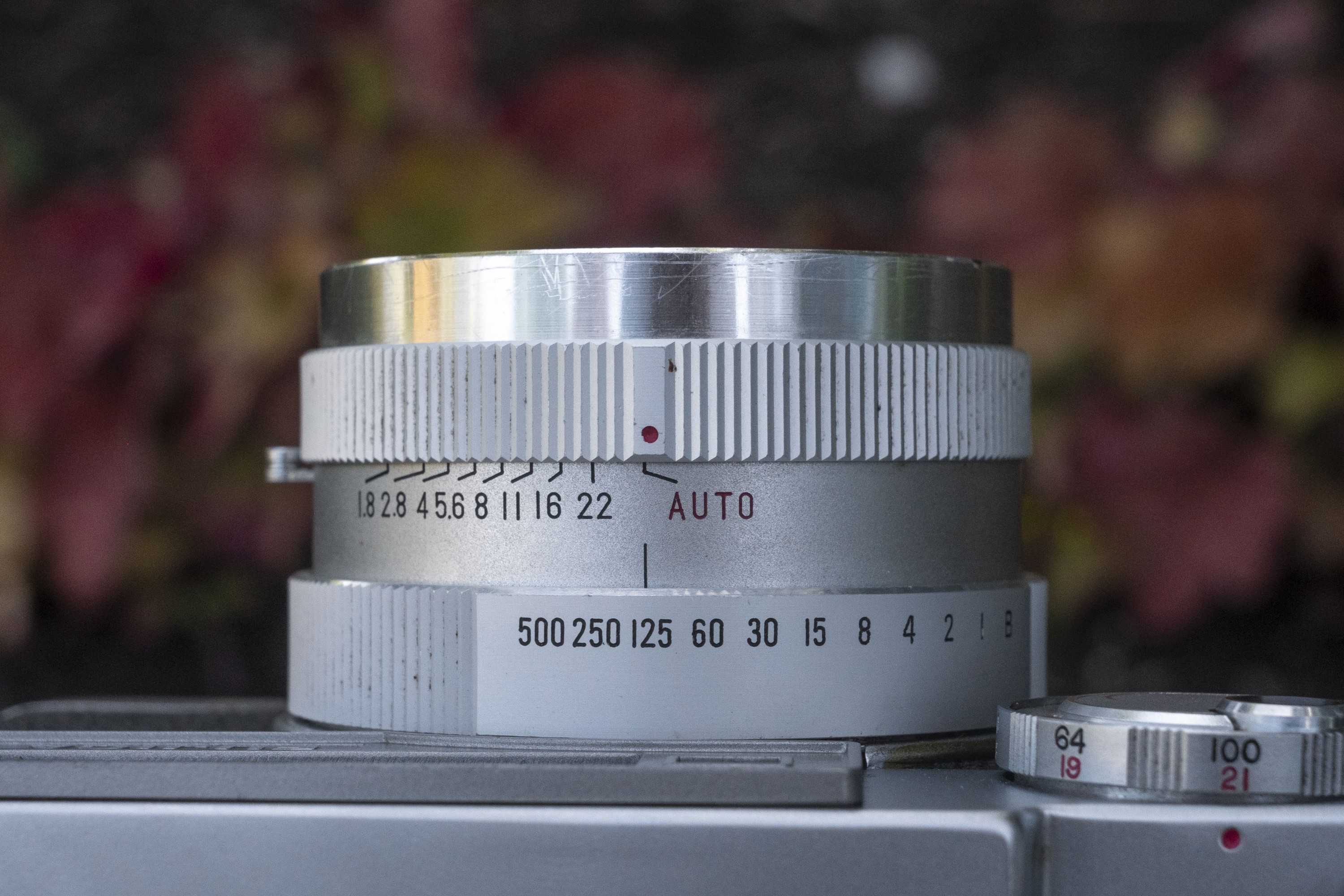
Eliminating the need for a focus ring around the lens, the Fujica V2’s two rings for shutter speeds and aperture f/stops are quite thick and very easy to locate with the camera to your eye.
Setting the aperture ring to the red Auto position enables shutter priority automatic exposure in which the camera controls the diaphragm, and you pick an appropriate shutter speed based on available light.
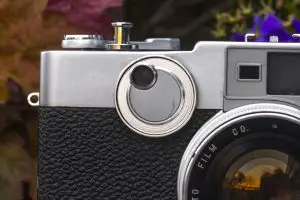
The CdS meter is mounted to the front of the body inside of a dial that is used to select the appropriate ASA film speed you are using. As this is a body mounted meter, you must manually make exposure corrections when using colored or neutral density filters on the lens. According to a short camera review I shared earlier in this article from the April 1966 issue of Modern Photography, the editors point out that the metering circuit is always on and can only be turned off by turning this ASA speed wheel to an unmarked position. I was not able to test this however, so if anyone reading this can confirm this is true or not, let me know in the comments section below.
A clever feature of the metering system is what Fuji calls the “Close-Up Light Lock” which is essentially an AE-lock feature which allows you to take a meter reading in strongly front or backlit situations, hold the exposure, compose your image, and then fire the shutter. To use this feature, you simply press and hold the shutter release about halfway at which point you’ll notice the meter needle in the viewfinder stops moving, holding the exposure, at which time you finish the process of composing and then making your exposure. Although AE-Lock features are common today, this was cutting edge stuff in 1964.

The Fujica V2’s viewfinder is one of my favorite parts of the camera as it shows both shutter speeds and aperture values, which wasn’t common of rangefinder cameras from this era. Sadly, I forgot to take a through the viewfinder picture before I traded the camera away to someone else. The image to the left is from the V2’s manual but gives a good idea of what it looks like. The aperture scale is on the right side and shows the available selection of f/stops, along with a meter needle which in Auto mode shows which setting the meter has detected. If not enough available light is detected to make a proper exposure, a red warning flag will appear.
Shutter speeds from 1/15 to 1/500 are indicated in the bottom left corner using projected numbers from what I imagine is some sort of transparent window inside of the viewfinder. As you rotate the camera through it’s various shutter speeds, the number changes. If you select a shutter speed below 1/15, this display changes to the word “SLOW”.
The frame lines automatically correct for parallax, which means that when focusing on close objects, the frame lines move towards the bottom right to account for parallax error. Finally, there’s the gold colored rangefinder patch which like other coincident image combined rangefinders, shows a double image that when lined up, means your subject is properly in focus.
The 1960s was the decade of Japanese large body 35mm rangefinders. A huge number of very similar models were produced by Minolta, Konica, Canon, Yashica, and others. The Fujica V2 is part of that group with just enough of a difference to stand out from the crowd. Features like the full information viewfinder, backwheel focus, and exposure lock allowed it to differentiate itself from the competition. But that was more than half a century ago, how does the Fujica V2 stand up today to the camera collector or user?
My Results
I shot two rolls of film through the Fujica V2, the first was expired Fuji 200 and the second a expired roll of AGFA APX25. APX 25 is an excellent fine grained slow speed black and white film that is sadly no longer made. I’ve shot a good number of rolls using this film and it has a rather high contrast which I hoped would work nicely with the sharp Fujinon lens.
Having shot a number of Fuji cameras with Fujinon lenses, I expected excellent images from the Fujica V2 and that’s what I got! Every image in the gallery above has excellent sharpness corner to corner with good contrast in both color and black and white. I will say though that it is interesting to see how quickly colors can fade on expired color film compared to black and white films which generally stay viable for much longer. The altered colors in the color Fuji film in no way had anything to do with the camera, and likely would have looked nicer had I used fresh film.
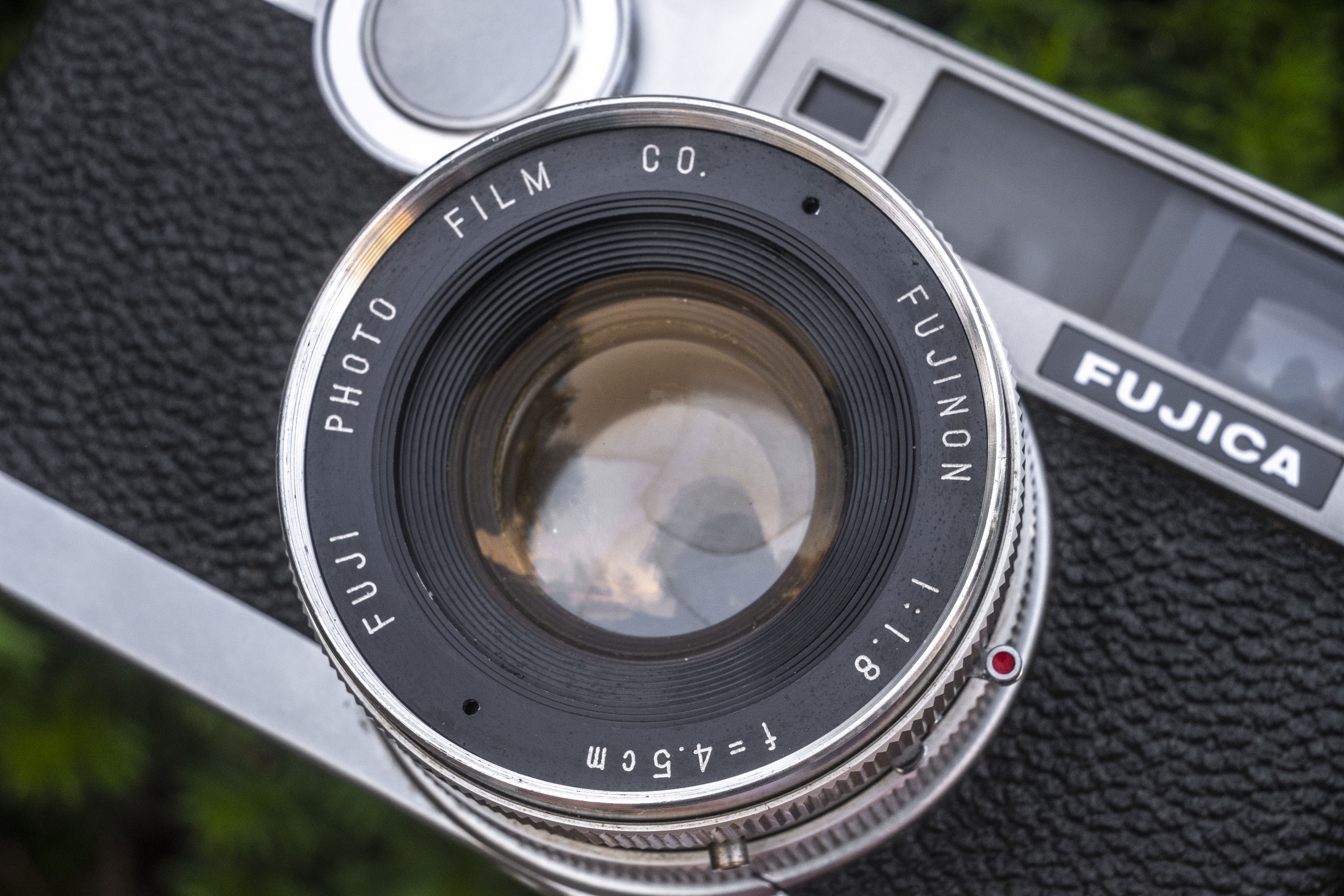
The 6-element Fujinon lens on the V2 is as good as anything made by other similar spec cameras of the era. In the era the V2 was produced, there was a lot of competition in this market and many good choices for people wanting an easy to use rangefinder with an excellent lens and some level of automation.
With a crowded market of similar cameras by Canon, Minolta, Konica, Yashica, and others, the Fujica V2 needed something to stand out from the crowd and that’s where unique features like the back wheel focus and full information viewfinder come in. None of these things makes the images you’d get from the camera any better, but they do affect the user experience.
I have consistently enjoyed using cameras with back wheel focus like the Fujica V2, Fujicarex, 35 ML, and Voigtländer Vitessa, Fuji’s implementation of it with the focus distance scale on the top plate is not convenient. It’s compact size with numbers very close together make it hard to read at a glance, and with no depth of field scale, makes zone focusing without using the rangefinder, difficult.
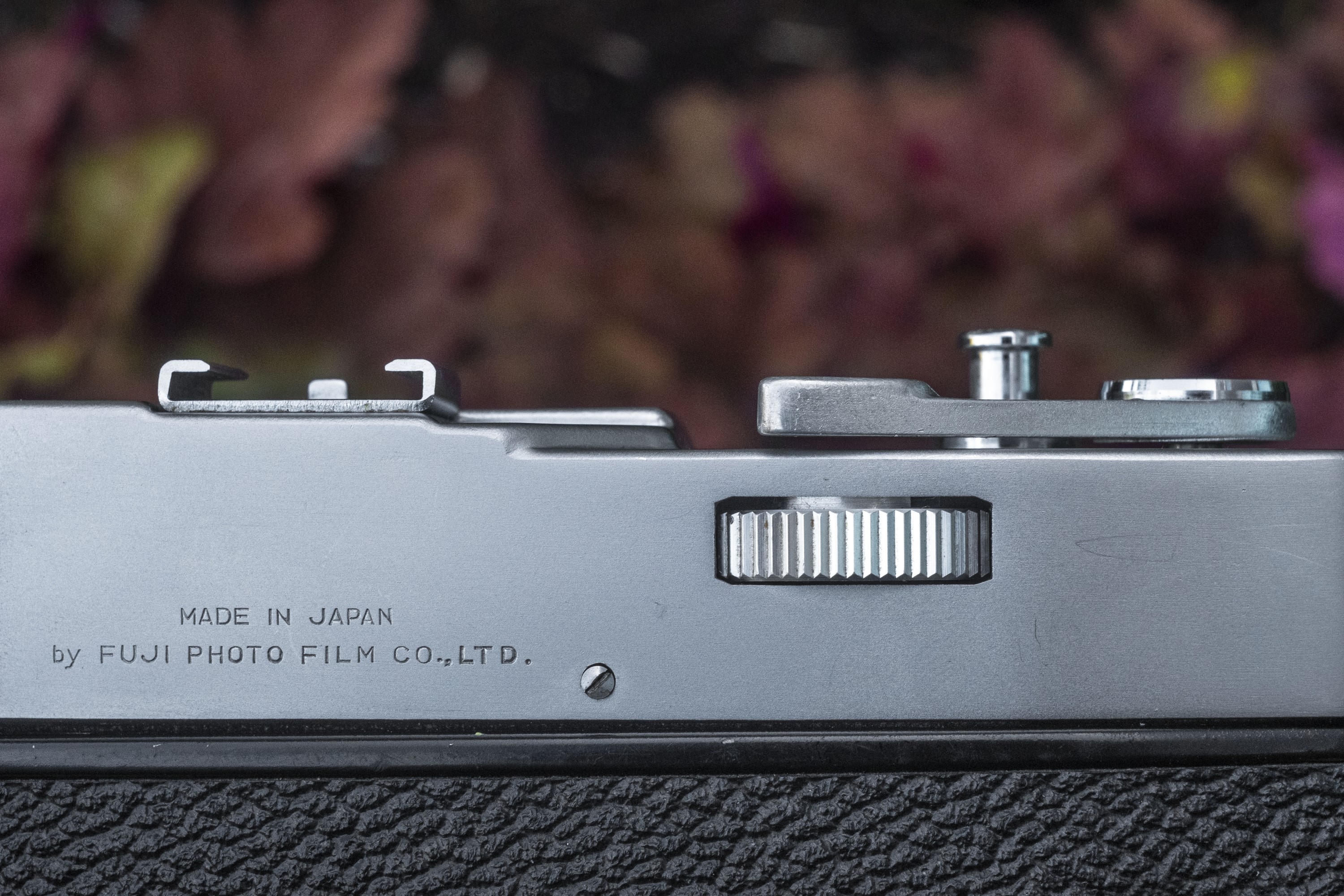
The viewfinder is excellent, and one of the best I’ve used on a fixed lens rangefinder, so for someone who values an excellent viewfinder, the Fujica V2 is just as hard to pass up today as it might have been back in 1965.
The Fujica V2 did not sell in large numbers, nor was it produced for a long time. I am not sure that slow sales and a short life has to do with any misgivings of the camera, rather, it was just a sign of the times. The 1950s established the Single Lens Reflex as a viable alternative to rangefinders for the pros, but it would take another decade for the advanced amateur market to catch up, which is exactly the target customer the Fujica V2 would have appealed to.
For me, I like the Fujica V2, but not just because of it’s lens or the images I got from it. I like it for the same reason I’ve liked other Fuji cameras of the era, that they eschewed a common pattern among Japanese camera makers who valued function over form, making technically excellent, but visually boring cameras. In the 1960s, Fuji was kind of like Nissan in that when Honda and Toyota were busy creating “vanilla” Accords and Camrys, Nissan was making the Maxima, a car that took a few more risks in it’s style, even if that meant it wouldn’t top the sales charts.
The Fujica V2 might be a better camera today than it was when it was new because collectors like myself seek out cameras that are just a little different than the countless Canonets and Minolta Hi-Matics out there. If you only want a good Japanese rangefinder with an excellent lens, close your eyes and just pick one. If however, you want something that looks and works just a little different, while still delivering the goods, get a Nissan Maxi….I mean a Fujica V2.
Related Posts You Might Enjoy
External Links
http://camera-wiki.org/wiki/Fujica_V2
https://ilottvintage.com/cameras/fujica-v2
http://www.35one20.com/2017/02/05/got-my-fujica-v2-fixed/
http://www.collection-appareils.fr/x/html/camera-10241-Fujica_V2.html

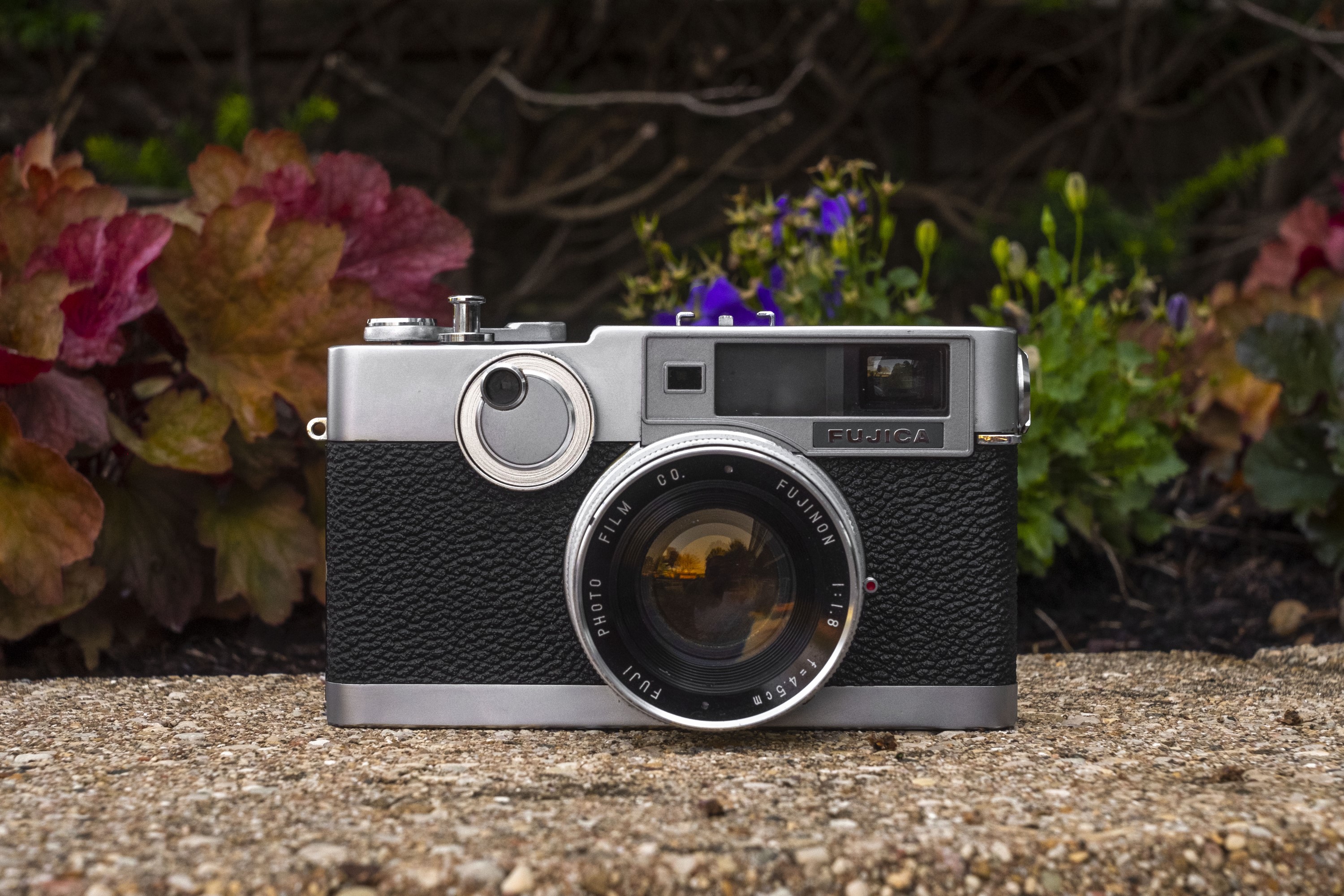
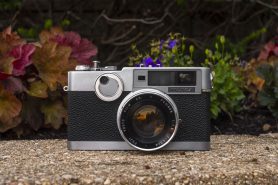
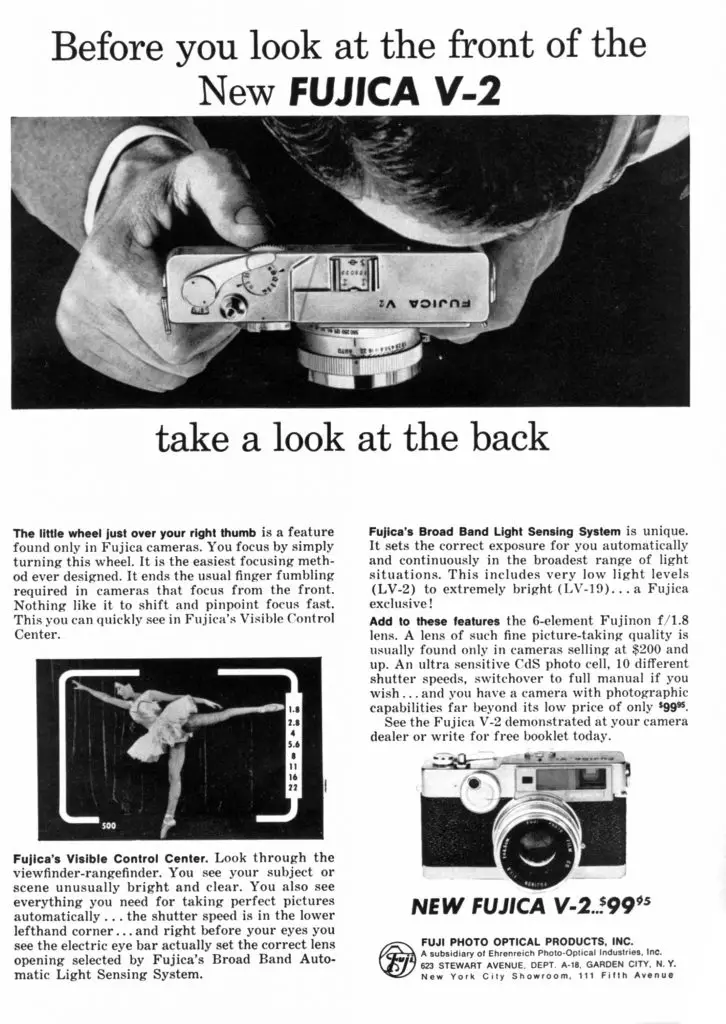
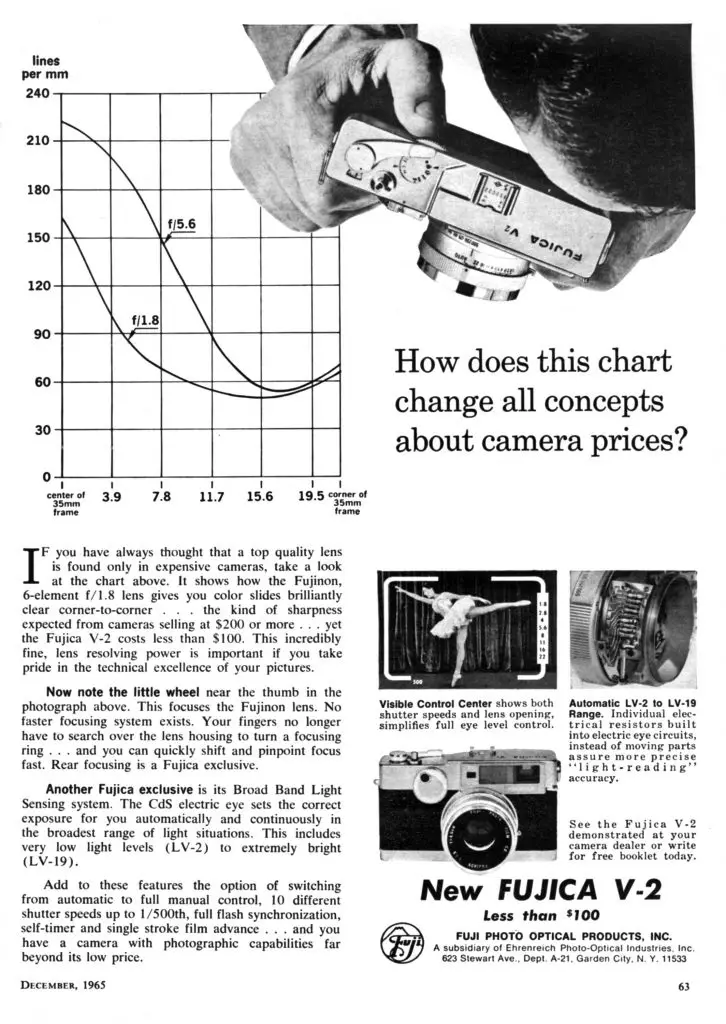























A fine camera, indeed – and not easy to locate in working condition. Fuji produced some of the world’s finest 645 / 66 / 67 / 69 rangefinders as well, your choice of fully manual or AE, easily found in working condition.
They are quite nice! To be honest, I’ve never had a bad experience with a Fuji camera, from the half frame Drive to their medium format cameras.
Really a good and informative review of one of most innovative camera producer of all times. I personal shoot with a Fuji Compact Deluxe. I choose this model over the V2 due to the fact that it uses one SR44 (LR44) batterie and not the banned mercury batteries. Very innovative for 1967. For the rest it is basically like the V2. Simple and a joy to use.
Glad you enjoyed the review. I’ve bid on a number of the Compact Deluxes as I prefer the smaller size and not needing mercury batteries as you state, but the Compact Deluxes regularly go for 2 to 3 times what the V2s go for. Apparently the word it out that those are great shooters!
Maybe I missed it in the article. But what does the battery actual function? I just found one of these cameras and it seems to be pretty much in wonderful condition. No battery in it currently. The shutter fires but the leafs don’t move…we’ll they twitch but don’t open at any speed.